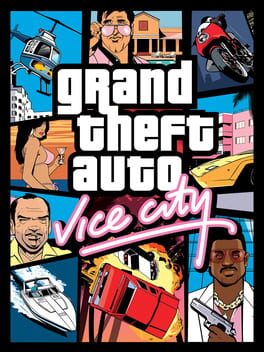The various landforms of Miami are interconnected with bridges that arch dramatically over the waterways, bringing about a ropey spatialisation in contrast to Grand Theft Auto III's boxed in claustrophobia. Driving around in Vice City you will never be glued to the road for too long because soon you will be flying. There's a kick to be had in noticing people go by in boats beneath you, because it reveals a cross section of the game-space where different surfaces follow different paths and call for different types of action. Vice City's horizons are all densely knotted with distraction, with other possibilities. The glistening ocean and waterways are a gelatinous mass that pulls turquoise ripples across the ocean floor more swimming pool than anything else, which all adds to the game's garish charm. In the spirit of 1980s excess everything in nature comes filtered through its artificial counterpart: every sunset and palm tree. Vice City is celebrated by fans for having every texture and action derived from an imploded database of 80s pop signifiers that's denser than dense, and happy to be that way. It also, maybe inadvertently, captures the ambiguous place of an artefact like Scarface in pop culture, in that it is presented here as both 'badass' and a work of seedy exploitation. To quote Waikay on this, however, "it is Scarface without de Palma, Pacino, and pathos". Not that the game needs to say anything Shakespearean necessarily, but beyond the reference it's just kind of empty.
And blank pastiche is the issue here. I don't see the point in distinguishing between form and content because any artist will tell you that expression is always negotiated between tools and ideas; moreso where the player/audience is involved. Focusing solely on game systems ignores the way we make sense of them sensorially in play, and likewise an account of only narrative beats and visuals precludes the way these things are actualised in-game. And so with Vice City there is a hypersaturated audiovisual style that nevertheless feels both naked and abrasive. Where every other Rockstar game has the player avatar firmly rooted to the ground beneath their feet (even to the detriment of responsiveness in later titles), Tommy's movements jerk in sharp directions and seems to flicker away just short of the game surfaces. I can understand this sense of irritation adding to its coked up atmosphere, but Tommy's twitchy body along with the game's more lightweight driving physics creates a distance between the player and texture of the world that just seems like a waste. It is always unfun to play, or, the pleasure is less in feeling your way through the game-space than in actively connecting your actions to the game's audiovisual signifiers. Sure, you get a chainsaw, but where is the weight of it? Where is the gravity of the scene it's referencing, or otherwise the pull of the machine itself? It doesn't help that the missions put more of an emphasis on combat than its predecessor but that its lock on and run system is even more scrappy. It's more stylised and grisly, but its flimsiness has it oscillate between agitation and frustration.
Again the case can be made for the amped up coke logic of its embodied play combined with the dizziness of its hollow 1980s signifiers. That's obviously enough if you buy it, but I need a sense of gravity in my ultraviolent sleaze.
And blank pastiche is the issue here. I don't see the point in distinguishing between form and content because any artist will tell you that expression is always negotiated between tools and ideas; moreso where the player/audience is involved. Focusing solely on game systems ignores the way we make sense of them sensorially in play, and likewise an account of only narrative beats and visuals precludes the way these things are actualised in-game. And so with Vice City there is a hypersaturated audiovisual style that nevertheless feels both naked and abrasive. Where every other Rockstar game has the player avatar firmly rooted to the ground beneath their feet (even to the detriment of responsiveness in later titles), Tommy's movements jerk in sharp directions and seems to flicker away just short of the game surfaces. I can understand this sense of irritation adding to its coked up atmosphere, but Tommy's twitchy body along with the game's more lightweight driving physics creates a distance between the player and texture of the world that just seems like a waste. It is always unfun to play, or, the pleasure is less in feeling your way through the game-space than in actively connecting your actions to the game's audiovisual signifiers. Sure, you get a chainsaw, but where is the weight of it? Where is the gravity of the scene it's referencing, or otherwise the pull of the machine itself? It doesn't help that the missions put more of an emphasis on combat than its predecessor but that its lock on and run system is even more scrappy. It's more stylised and grisly, but its flimsiness has it oscillate between agitation and frustration.
Again the case can be made for the amped up coke logic of its embodied play combined with the dizziness of its hollow 1980s signifiers. That's obviously enough if you buy it, but I need a sense of gravity in my ultraviolent sleaze.
